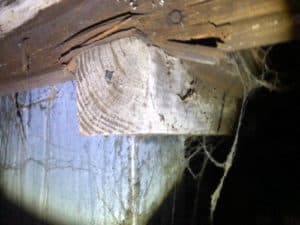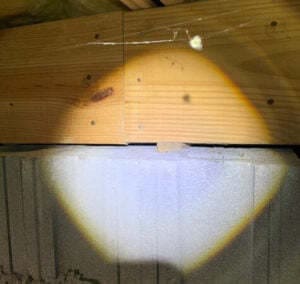We can fix even the most stubborn sagging floors.
Your floor is supposed to be a smooth, even surface that is firm and steady beneath your feet. It is not supposed to have ridges like a potato chip. It should not offer a kid-friendly ski slope to one side, nor give way to you like memory foam insoles. And there is definitely not supposed to be a visible gap smiling at you between the baseboard trim and your flooring. You know these are signs of uneven floors, but do you know what causes them? Don’t worry, we can fix all of those issues.
Our company specializes in sagging floor repair in Cicero, IL. Our sagging floor experts can fix just about any issue regarding sagging or bowed floors. Contact us today to get your free estimate and what it will take to fix your sagging floors.
What causes floors to sag? A sagging floor is a sign that the “bones” of your home are diseased or damaged. In our experience, the earlier these issues are detected and addressed, the less expensive the repairs are. At Acculevel, we’ve been repairing sagging floors, warped floors, bowed floors and structural wood flooring systems since 1996.
WHAT CAUSES A SLAB FLOOR TO SAG?
Unlike homes with basements or crawl spaces, a slab floor is solid concrete with no structural wood flooring system. For homes with this type of floor, soft soil or bad compaction is almost always the culprit. Once the soil is compromised, the slab will shift, and this creates the sagging or sinking effect. Pressure from that shift will sometimes crack the slab itself, causing high and low places in the flooring. To fix this type of damage, you need concrete slab repairs.
WHAT CAUSES A FLOOR TO SAG IF YOU HAVE A BASEMENTS OR CRAWL SPACE?
For basements & crawl spaces, the suspect pool is considerably larger. The support structure is mostly wooden, which makes it susceptible to a variety of issues.
Water
Water is a probable suspect, as it seeps into the ground around your foundation. The sill plate, wood beams, and floor joists are all vulnerable to this; these wooden components on top of your foundation are the wood framing system that supports your floor. Because it has direct contact with the concrete and can be over the exposed soil line, it often falls victim to water intrusion. Once water intrudes and saturates the wood, this leads to deterioration. It’s this deterioration that causes the floor system to fail.
This joist is badly decayed, splintering around the beam. This picture was taken by an Acculevel Project Manager on a routine free estimate appointment.
This picture was taken by an Acculevel Project Manager on a routine free estimate appointment.
Humidity
But you don’t have to have standing water under your house to cause structural decay. High humidity can also damage the beams and joists that hold up your subfloor. Wood is highly porous and readily absorbs water from the air. Over time, this water saturation softens and rots the boards. As they decay, they compress under the weight of your home, lowering your floor sometimes by several inches.
Insects
Insects are another frequent perpetrator; termites are a well-known home invader. But there are also several subspecies of beetles that eat wood. Powderpost beetles are common and difficult to recognize. They’re very small- the average adult beetle is smaller than a grain of white rice. These tiny menaces lay their eggs inside wooden beams, and when they hatch, the larvae eat the wood. Both beetles and termites will infest your structural wooden flooring system and gnaw damage as they go.
Human Error
Human error is another possibility, particularly if your home has been retrofitted with updated plumbing, electrical, or HVAC products. Making room for these types of installations can be difficult, and sometimes a contractor will cut or notch some of the joists- or even the main support beam- to make room for new pipes or venting. These cause weak spots in the flooring structure that will eventually crack or split.
Age of Your Home
Lack of building codes- or outdated ones- are another concern. A main support beam, the post that spans the length of your home, should be sized proportionately and supported every few feet. In many homes, the beams may not be the correct size or the support posts are installed too far apart. This over-spanning puts greater stress on the beam and makes it more likely to sag and potentially even fail.
Along the same lines, if your home is more than 50 years old, it’s also possible that inadequate materials are to blame. When a home is built, sometimes the beams or joists are not the correct dimensions. When this happens, a contractor will install a shim; a shim is a thin piece that adds a minimal lift to ‘even out’ the installation. Many times in construction, that shim was usually another piece of wood; at Acculevel we use steel shims to prevent compression or rot. These shims also allow us to increase the overall surface of the bearing load, so that the beam it’s supporting is not crushed by the weight of your home.
The wooden shim has compressed, lowering the joist. This picture was taken by an Acculevel Project Manager on a routine free estimate appointment.
This picture was taken by an Acculevel Project Manager on a routine free estimate appointment.
Technology
Technology is another age-related factor. New solutions and materials are always in development, but they take time to become commonplace. Before the 1970s, pretreated or pressure-treated lumber was not widely available or regularly used by builders. Lumber installed in its original ‘raw’ form is more vulnerable to insects and water damage.
New trends in home design can have a negative effect if a remodel doesn’t take the weight of the raw materials into account. Many older homes aren’t built to carry the load of solid granite countertops or stone-tiled floors and walls. Recreational items like a pool table or hot tub will also add significant weight to your floor system. These are all items that can put additional stress onto an already failing wood structure.
Take Action
Contact Acculevel! We provide free estimates on sagging floor repairs.



















